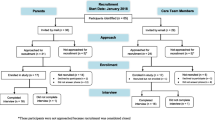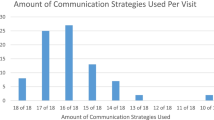Abstract
The purpose of this study was to compare the communication patterns of pediatricians with parents of children with special health care needs (CSHCN) and parents of healthy children to explore whether there were significant differences in communication patterns and satisfaction. Ten pediatricians were audiotaped during 97 outpatient medical encounters. Analyses of variance (ANOVAs) were used to examine communication patterns based on children’s health status. Results showed that although pediatricians did not differ in their frequencies of communications, parents of CSHCN contributed more medical-related information and had higher rates of social exchanges and questions than parents of healthy children. CSHCN also participated more than healthy children. Children’s health status did not influence pediatrician or parent satisfaction ratings of the visit. Pediatricians’ satisfaction ratings were higher in medically oriented encounters, whereas parents’ satisfaction ratings were not related to communication patterns. The results of this study underscore the role of parents of CSHCN in communicating medical information, as well as the importance of pediatrician–family relationships to families of CSHCN.
Similar content being viewed by others
References
American Academy of Pediatrics. (2003, August 27). Medical/Behavior/Psychosocial Complexity Levels. Retrieved March 9, 2004, from htttp://www.medicalhomeinfo.org/ tools/tools/complexity.doc
Bass, M. J., Buck, C., and Turner, L. (1986a). Predictors of outcomes in headache patients presenting to family physicians-a one-year prospective study. Headache 26: 285–294.
Bass, M. J., Buck, C., Turner, L., Dickie, G., Pratt, G., and Robinson, H. C. (1986b). The physician’s actions and the outcome of illness in family practice. Journal of Family Practice 23: 43–47.
Bryan, T., and Burstein, K. (2000). Parents as partners in the medical home: Choosing a physician. Exceptional Parent 30: 76–80.
Burstein, K., and Bryan, T. (2000). Parents as partners in the Medical Home Project-Part 5: The Family-Centered Medical Bill of Rights. Exceptional Parent 31(2): 52–56.
Burstein, K., Bryan, T., Chao, P. C., Hirsch, D., Berger, K., Stiles, N., and Cortese, T. (2003, September). Quality health care for children with special needs in a medical home. Paper presented at the meeting of the Maricopa Health Foundation and Southwest Institute for Families and Children with Special Needs on Caring for Children with Special Health Needs: Challenges and Strategies for Primary Care, Scottsdale, AZ.
Carraccio, C. L., Dettmer, K. S., duPont, M. L., and Sacchetti, A. D. (1998). Family member knowledge of children’s medical problems: the need for universal application of an emergency data set. Pediatrics 102: 367–370.
Center for Medical Home Improvement. (2001). Domain 2: Chronic Condition Management, Center for Medical Home Improvement, Lebanon, NH.
Epstein, R. M., Campbell, T. L., Cohen-Cole, S. T., McWhinney, I. A. and Smilkstein, G. (1993). Perspectives on patient–doctor communication. J. Fam. Pract. 37: 377–388.
Institute for Family-Centered Care. (1995). Family Centered Care for Children With Special Health Care Needs, Institute for Family-Centered Care, Bethesda, MD.
Maternal and Child Health Bureau. (1995). National Agenda for Children With Special Health Care Needs: Achieving Goals 2000, Maternal and Child Health Bureau, Rockville, MD.
Newacheck, P., and Stoddard, J. (1994). Prevalence and impact of multiple childhood chronic illnesses. J. Pediatr. 124: 40–48.
Newacheck, P. W., Strickland, B., Shonkoff, J. P., Perrin, J. M., McPherson, M., McManus, M., Lauver, C., Fox, H., and Arango, P. (1998). An epidemiologic profile of children with special health care needs. Pediatrics 102: 117–123.
Pantell, R. H., Stewart, T. J., Dias, J. K., Wells, P., and Ross, A. W. (1982). Physician communication with children and parents. Pediatrics 70: 396–402.
Reames, H., and Dunstone, D. C. (2001). Physician satisfaction revisited. Soc. Sci. Med. 52: 825–838.
Roter, D. L., Stewart, M., Putnam, S. M., Lipkin, M., Stiles, W., and Inui, T. S. (1997). Communication patterns of primary care physicians. J. Am. Med. Assoc. 277: 350–356.
Van Dulmen, A. (1998). Children’s contributions to pediatric outpatient encounters. Pediatrics 102: 563–568.
White, P. H. (1997). Success on the road to adulthood. Pediatr. Rheumatol. 23: 697–707.
Author information
Authors and Affiliations
Corresponding author
Rights and permissions
About this article
Cite this article
Burstein, K., Bryan, T., Chao, P.C. et al. Communication Patterns of Primary Care Pediatricians, Parents, and Children with and Without Special Health Care Needs. J Dev Phys Disabil 17, 249–262 (2005). https://doi.org/10.1007/s10882-005-4382-z
Issue Date:
DOI: https://doi.org/10.1007/s10882-005-4382-z




